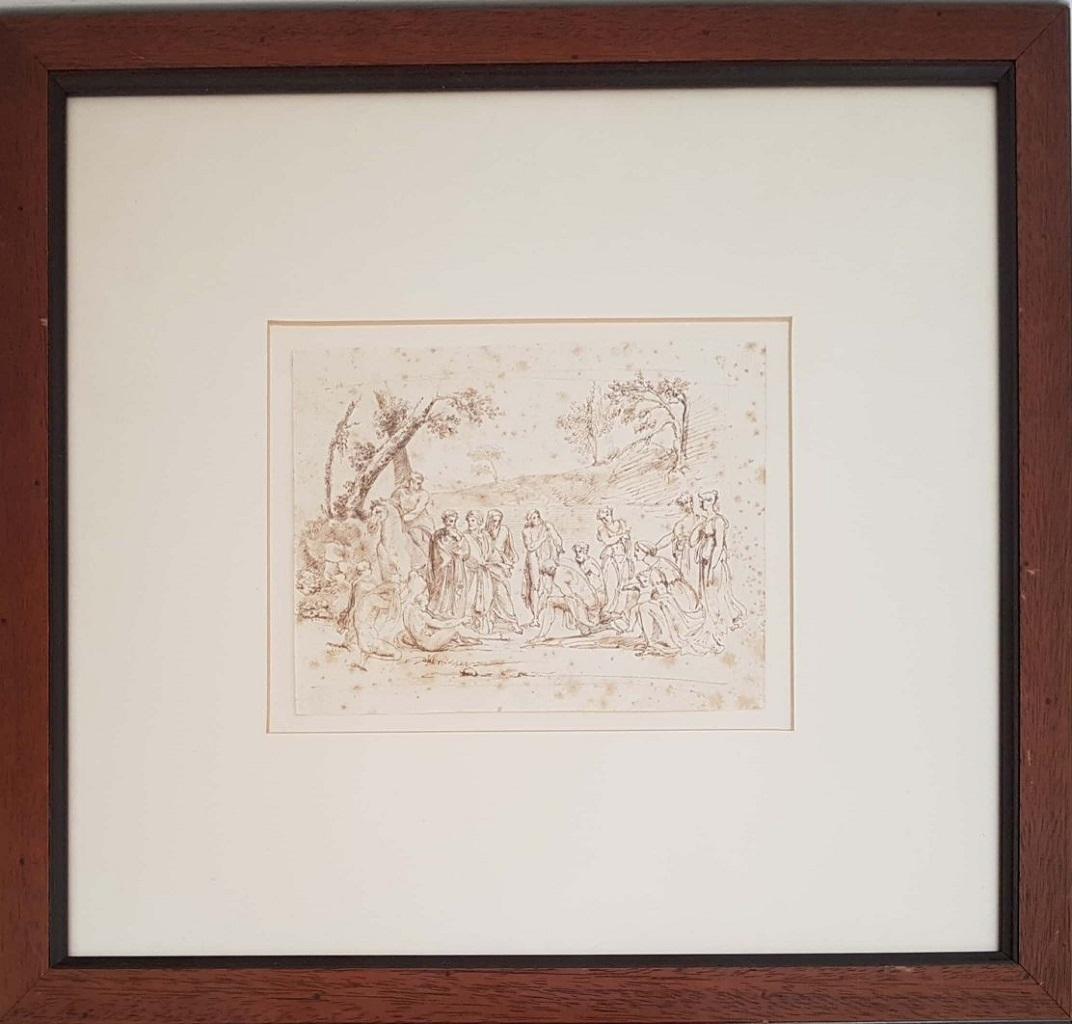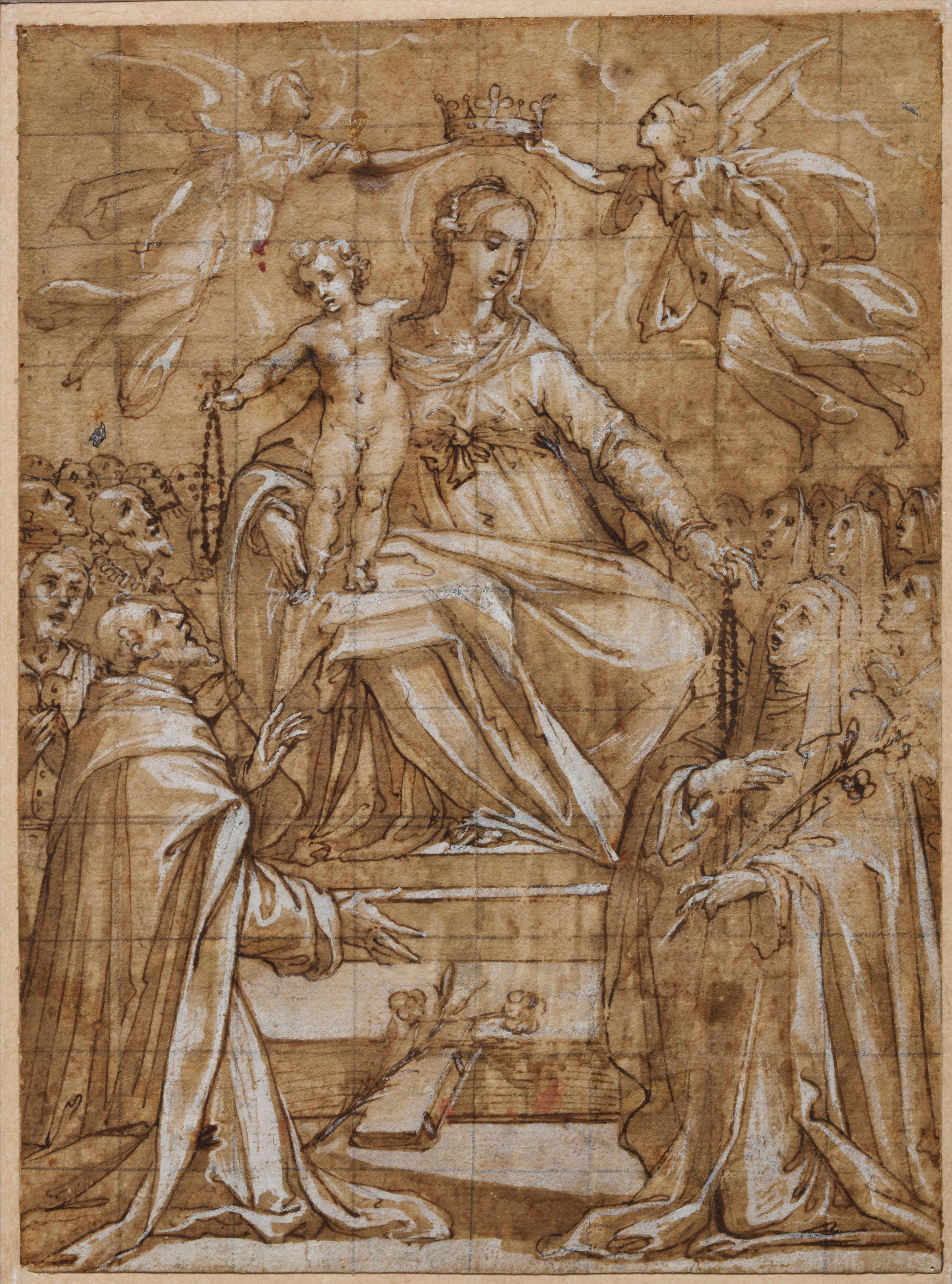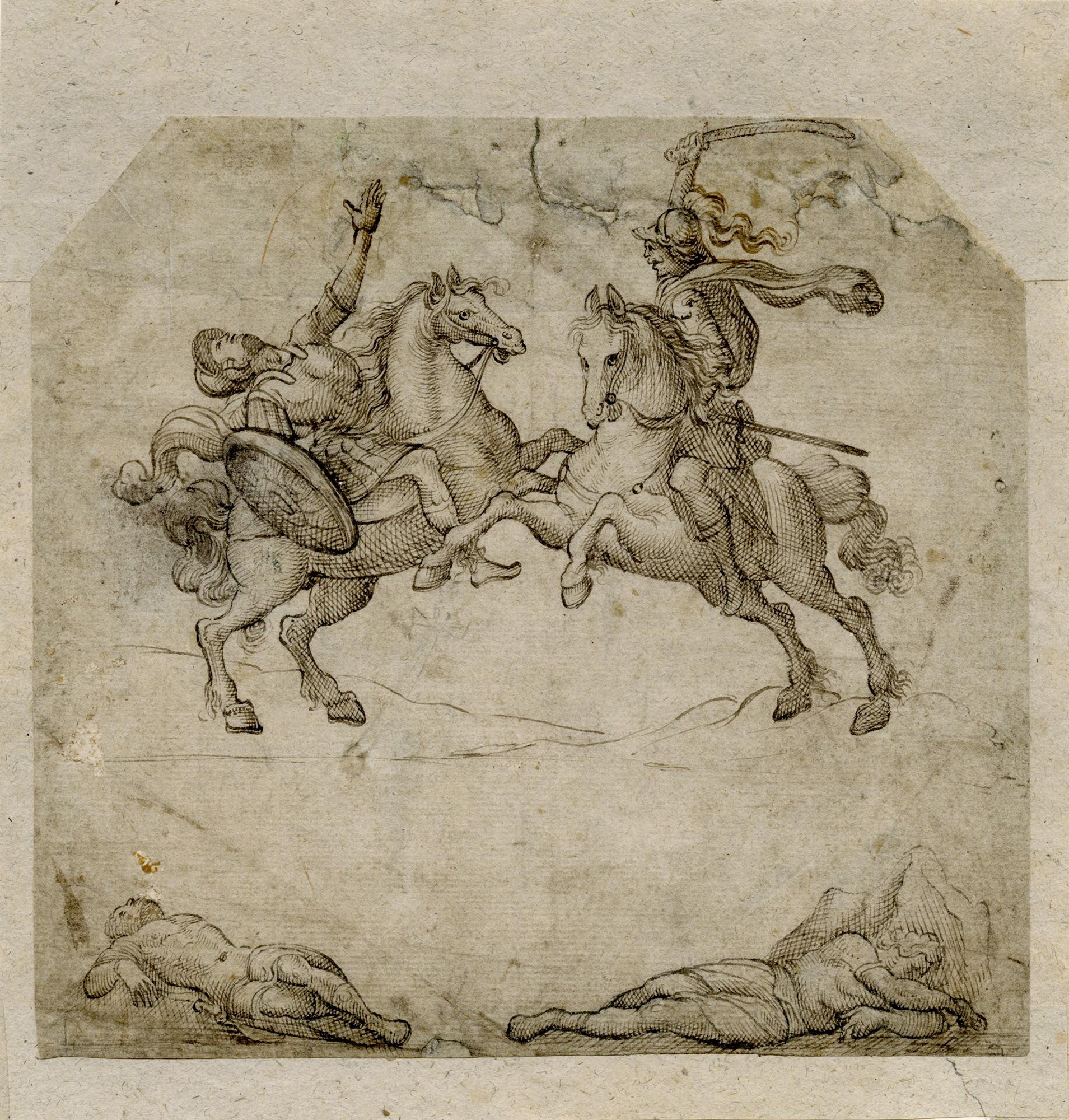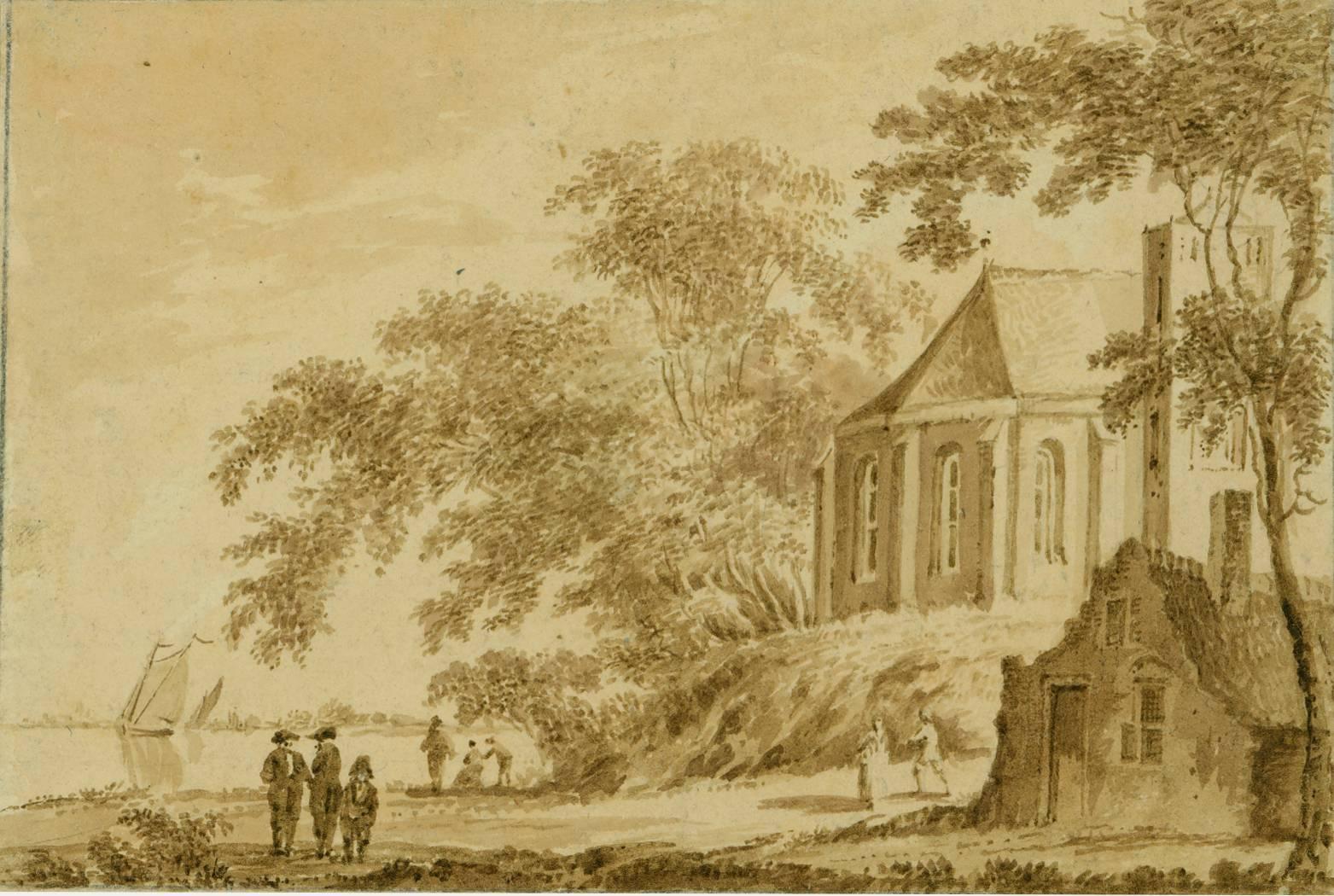Items Similar to H F Gravelot (1699-1773) Two Allegories, Faith and Vigilance, Pen and Ink
Video Loading
Want more images or videos?
Request additional images or videos from the seller
1 of 9
Hubert-François GravelotH F Gravelot (1699-1773) Two Allegories, Faith and Vigilance, Pen and Inkcirca 1760
circa 1760
About the Item
Hubert-François Gravelot (1699-1773)
Two Allegories : Vigilance and Faith
Pen, black Ink, and black wash on paper
7.9 x 4.8 each one
Framed 22 x 26 cm
Old framing that needs to be restored
Vigilance can be identified with the cock at her feet that symbolises attention. Faith of course is more easily identifiable with the cross she holds.
Hubert-François Bourguignon d'Anville, known as Gravelot (March 26, 1699 - April 19 , 1773) was an illustrator, engraver, illustrator and painter who enjoyed some success in London at the beginning of the 18th century and gave the impression there of the "French taste".
From 1732 to 1745, Gravelot moved to London . Although subject to Anglomania as many of his compatriots, he went there at the invitation of the engraver Claude Dubosc (1682-1745) to work on the engravings of the English edition of the work of Bernard Picart , Treaty of the religious ceremonies of all nations. Engraver George Vertue's notebooks have a very positive appreciation of Gravelot's style. The latter then begins to attend an artists' society, the St Martin's Lane Academy run bWilliam Hogarth, at a time when London had no gallery, no museum, no exhibition, not even a school which was the equivalent of the Royal Academy in Paris. Plover takes as a student Thomas Gainsborough who will become one of the most important painters of the English school of the 18th century. Gravelot is undoubtedly one of the promoters of rococo in England, so much he exceled in the art of ornament . Gravelot also distinguished himself in his illustrations and rockeries which he had made for cabinet makers, upholsterers and boilermakers, who were a source of inspiration for goldsmiths, upholsterers and cabinetmakers among whom are Thomas Chippendale not to mention the miniaturists working for the Chelsea porcelain factory .
His illustrations, including 35 frontispieces for the only edition of Shakespeare's Complete Works in 1744, influenced English artists and he worked alongside engraver like Gerard van der Gucht . There is also the Pamela: gold, Virtue rewarded by Samuel Richardson that he illustrated in 1741 from compositions painted by Francis Hayman .
The anti-French sentiments triggered by the Battle of Fontenoy in 1745 brought Gravelot back to Paris in October, where, accompanied by one of his pupils, Thomas Major, and a fortune estimated at 40,000 livres , he had no difficulty to use his talents.
He illustrated the History of Tom Jones Fielding (1750), the Decameron (1757), the New Heloise (1761), the Moral tales of Marmontel (1765), Metamorphoses of Ovid (1767-71), Jerusalem delivered from Tasse (1771) but also the complete works of Corneille, Racine and Voltaire: some of these illustrated books are considered as among the most beautiful of this time.
A great reader, Gravelot was the brother of the geographer Jean-Baptiste Bourguignon d'Anville, with whom he worked on a series of maps and wrote his eulogy in which he recalls his bibliomania.
Quentin de La Tour painted his portrait at the Salon of the Royal Academy of Painting and Sculpture in 1769.
- Creator:Hubert-François Gravelot (1699-1773, French)
- Creation Year:circa 1760
- Dimensions:Height: 3.12 in (7.9 cm)Width: 1.89 in (4.8 cm)
- Medium:
- Movement & Style:
- Period:1760-1769
- Condition:
- Gallery Location:Paris, FR
- Reference Number:
About the Seller
5.0
Gold Seller
These expertly vetted sellers are highly rated and consistently exceed customer expectations.
Established in 2018
1stDibs seller since 2019
210 sales on 1stDibs
Typical response time: <1 hour
- ShippingRetrieving quote...Ships From: Paris, France
- Return PolicyA return for this item may be initiated within 14 days of delivery.
More From This SellerView All
- French Neo classical school, Allegory of Time, original drawingLocated in Paris, FRNeo classical school, France, end of the 18th Century Allegory of Time, Pen and black ink on paper, gray ink wash 30.5 x 19 cm irregularly shaped In g...Category
1790s Old Masters Nude Drawings and Watercolors
MaterialsIndia Ink
- French School Of The 18th century, An Ancient Shipyard, DrawingLocated in Paris, FRFrench school of the 18th century An ancient shipyard or building site (?) Ink and ink wash on paper 17.5 x 23 cm In a modern frame 32 x 37 cmCategory
1780s Old Masters Figurative Drawings and Watercolors
MaterialsInk
- Joachim von Sandrart (1606-1688) Biblical episodes, 3 original drawingsBy Joachim von SandrartLocated in Paris, FRJoachim von Sandrart (1606-1688) Three Biblical episodes, 3 original drawings - The Ascent of Elijah - The Judgment of Solomon - Benjamin receiving presents Each one : 9.2 x 7.7 cm...Category
1640s Old Masters Figurative Drawings and Watercolors
MaterialsInk
- Louis-Félix de La Rue (1730-1777) A Mythological scene, drawingBy Louis-Félix DelarueLocated in Paris, FRLouis-Félix de La Rue (1730-1777) A biblical or mythological episode Signed and dated lower right (under the mount, see photos of the drawing out of frame) ...Category
1770s Old Masters Figurative Drawings and Watercolors
MaterialsInk
- François Boitard (1670-1715) Abraham and the Three Angels, original drawingLocated in Paris, FRFrançois Boitard (1670-1715) Abraham and the Three Angels, Signed lower left "Boitard (...) fecit (...)" 28 x 44 cm Pen and ink on yellow prepared paper I...Category
Early 1700s Old Masters Figurative Drawings and Watercolors
MaterialsInk
- Louis-Félix de La Rue (1730-1777) Putti playing around a sculpture, drawingBy Louis-Félix DelarueLocated in Paris, FRLouis-Félix de La Rue (1730-1777) Louis Felix de la Rue anges en farandoleA Mythological scene Pen and brown ink on paper 15.4 x 31 cm In good condition The ancient mount has has a...Category
1770s Old Masters Figurative Drawings and Watercolors
MaterialsInk
You May Also Like
- Female Nudes - Charcoal, Ink and Watercolor DrawingLocated in Roma, ITFemale Nudes is a fine original drawing (China ink and watercolor on paper). Unsigned. This artwork could be attributed to Thomas Stothard. Although th...Category
Mid-19th Century Old Masters Figurative Drawings and Watercolors
MaterialsCharcoal, Ink, Watercolor
- Madonna della ScodellaLocated in Roma, ITMadonna della Scodella is an original drawing (black pencil, pen and ink on laid paper) by an exponent of the Italian school of the eighteenth century. In excellent conditions: almo...Category
19th Century Old Masters Figurative Drawings and Watercolors
MaterialsInk
- Baptism of Christ - Ink Drawing by Anonymous XIX CenturyLocated in Roma, ITBaptism of Christ is a beautiful original drawing (pen and ink on paper) by an anonymous of the Neoclassical school of the beginning of the 19th century. A ...Category
19th Century Old Masters Figurative Drawings and Watercolors
MaterialsInk
- Modello for the Virgin of the Rosary, a drawing by Francesco Vanni (1563 - 1610)Located in PARIS, FRFrancesco Vanni is one of the last representatives of the long Sienese pictorial tradition. In this masterly composition in pen and ink wash, he presents the Virgin of the Rosary, holding the Child Jesus on her lap, surrounded on her right by Saint Dominic and on her left by Saint Catherine of Siena. The presence of these two emblematic saints of the Dominican order is a reminder of the devotion of this order to the Rosary. 1. Francesco Vanni, a Sienese painter of the Counter-Reformation Francesco Vanni was the most important Sienese painter of the late sixteenth century and a key Italian Counter-Reformation painter. He developed a very specific style, inspired not by Florentine models but rather by the Roman, Bolognese and Marche schools, and in particular by the work of his contemporary Federico Barocci (Urbino 1535 - 1612), despite the two artists never meeting. Francesco Vanni was born in Siena around 1563-1564. His father died in 1567 and his mother remarried Arcangelo Salimbeni (1536 - 1579), then one of Siena’s leading painters. His half-brother Ventura Salembini (1568 - 1613) also became a well-known painter. He continued his apprenticeship in Bologna and Rome, where he joined the painter Giovanni de Vecchi’s (1536 - 1614) studio, where he was greatly influenced, like other Tuscan painters of the time, by the art of Federico Barocci. He devoted himself mainly to religious painting, following the canons of the Counter-Reformation. Travelling between Siena, Rome, Bologna and Parma, in 1604, he settled in Siena, where he ended his life. Vanni was also an important member of the Confraternity of the Sacro Chiodo, renowned for its demanding religious practices. His legacy also includes some important engraved work. 2. Description of the artwork The Virgin is depicted enthroned in majesty, slightly taller than the other figures that she dominates from her pedestal. Her wide robe with marked folds evokes Renaissance statuary. She is crowned by two angels in the sky. These two angels are a reminder of the custom of adding angels to crown 13th century icons which was frequent at Vanni’s time. The Child Jesus is standing on the Virgin’s right knee. With her left hand she holds out a rosary to Catherine of Siena, identifiable by a branch of lily in her hand. In a symmetrical gesture, the Child Jesus also holds out a rosary to St Dominic. Two of St Dominic’s attributes are to be found at the foot of the Virgin: a book and a branch of lilies. Vanni gives particularly delicate treatment to St. Dominic's long and slender hands. The two outstretched rosaries form the link between the heavenly register of the Virgin and the Child Jesus and the earthly register of the two Dominicans who are not crowned with a halo. This and the fact they are followed by a large crowd, indicates that they are both represented as part of the multitude of the living called to pray to the Rosary. According to the classical iconographic tradition, it would be plausible to consider that the figure looking at the viewer on the extreme left of the drawing could be a self-portrait of the painter. Francesco Vanni's face is known to us from a self-portrait kept in the Pinacoteca Nazionale in Siena. The squaring of the drawing suggests that it was used for a larger-scale altarpiece, probably for a church dedicated to St Dominic or for a Dominican convent. As of today, we have not identified the painting for which this drawing served as a preparatory modello. The Madonna of the Rosary in the Cathedral of Pitigliano (painted by Francesco Vanni in 1609) differs quite significantly from our drawing by the addition of Pope Pius V, and the inclusion of St. Dominic and St. Catherine in the celestial register. We believe that our drawing predates this painting because of its more symmetrical composition, and less Baroque influence. The presence of Saint Catherine of Siena, particularly venerated in his native town, to which Francesco Vanni returned frequently from 1590 onwards, leads us to propose a date of around 1590 - 1600 for this drawing. 3. The Rosary and the Dominican Order In order to clarify the iconographic meaning of this artwork, it is worth recalling the role of Saint Dominic in the spread of the Rosary prayer. Dominic Nuñez de Guzman was born around 1170 in Caleruega (near Burgos) in Spain and died in 1221 in Bologna, Italy. He was the founder of the order of friar preachers, commonly known as the Dominicans. He was canonised by the Church in 1234 and has since been celebrated under the name of Saint Dominic. After three days of prayer in the forest of Bouconne, near Toulouse, Dominic is said to have received the Rosary as a means of converting the Cathar population. The Dominicans subsequently made a special effort to promote this form of meditative prayer. Pope Pius V, a Dominican, included the feast of the Rosary (on October 7th) in the liturgical calendar in 1571. Rosary prayer has evolved over the centuries and traditionally consists of the recitation of three rosaries (four since St John Paul II). Each rosary consists of five tens of "Hail Mary...Category
16th Century Old Masters Figurative Drawings and Watercolors
MaterialsPen, Ink
- Mythological combat scene with Roman soldiers on horseback.By Virgil SolisLocated in Middletown, NYPen and brownish black ink on grayish-cream laid paper, 6 1/2 x 8 inches (165 x 175 mm), irregular hexagonal sheet with margins. Some archival repairs along the top sheet edge, scatt...Category
16th Century Old Masters Figurative Drawings and Watercolors
MaterialsPen, Laid Paper, Ink
- View of the KagermeerBy Hendrick V. TavernierLocated in Storrs, CTInk and watercolor on paper. 3 1/2 x 5 1/4. Unsigned. Excellent condition on cream laid paper, tipped onto a backing sheet at the top corners. Annotated "Tavernier" verso, and "Hendr...Category
Late 19th Century Old Masters Landscape Drawings and Watercolors
MaterialsInk, Watercolor





